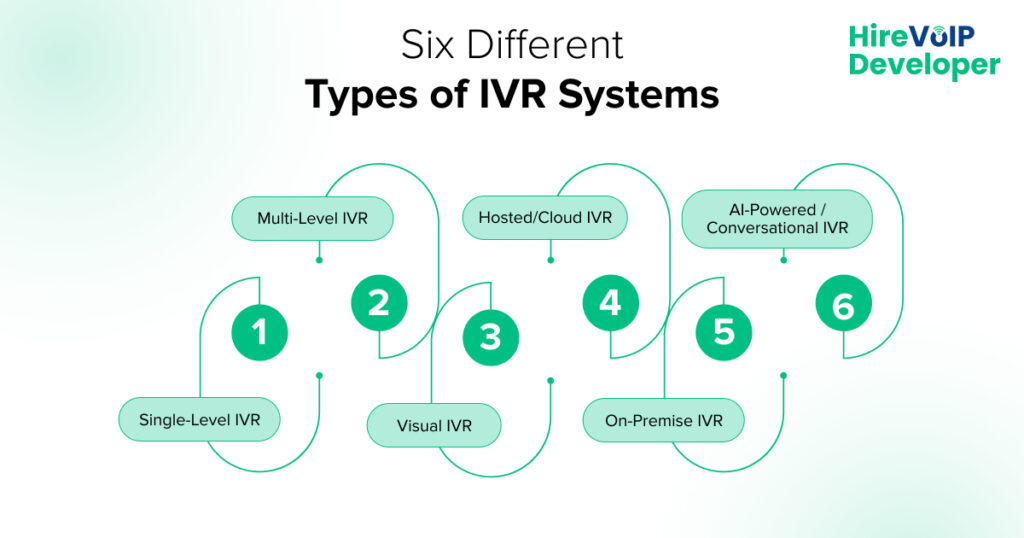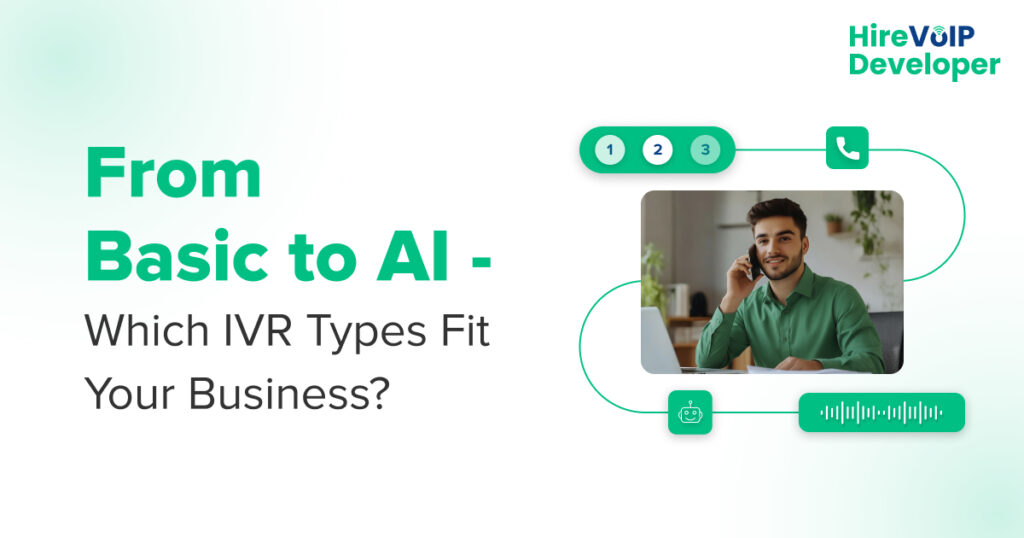🗝️ Key Highlights
✅ Breakdown of different IVR types, from basic single-level menus to advanced AI-driven conversational systems, and how they fit different business needs.
✅ Insights into industry-wise applications, security, compliance requirements, and migration from legacy IVR to modern solutions.
✅ Practical guidance on choosing the right IVR for your business, with expert support from Hire VoIP Developer for seamless deployment and scalability.
Ever called a business and been guided smoothly to the right department without waiting endlessly?
That’s the power of a customized IVR solution at work!
It ensures that customers don’t waste time bouncing from one agent to another and businesses don’t struggle with chaotic call management.
This blog is designed to help businesses understand the different types of IVR systems, their pros and cons, and how each type fits different industries. By the end, you’ll have clarity on “Which IVR type is best for my business?” and how to make an informed choice that improves both efficiency and customer experience.
What is an IVR System and Why Does It Matter for Businesses?
Let’s start with the basics before diving into IVR types.
An Interactive Voice Response (IVR) system is an automated telephony solution that lets customers interact with a pre-recorded menu using voice commands or keypad inputs. Think of it as a virtual receptionist, one that works 24/7 without breaks or delays.
For businesses, IVR is more than just call routing. It streamlines communication, reduces the workload on agents, and cuts operational costs by handling routine queries automatically. A well-designed IVR system ensures customers feel guided, not stuck, and reach the right department faster.
👉How would you rate your current phone system’s ability to route calls?
✅ Thanks for voting!
Now that we’ve defined IVR, let’s look at the types of IVR systems available.
Six Different Types of IVR Systems
Not all IVR systems are created equal! Some are simple and straightforward, while others are advanced and AI-driven. The type you choose depends on your business size, customer needs, and the complexity of your call routing requirements. Think of it like picking the right tool for the job.
In this section, we’ll walk through the most common IVR types, from basic single-level menus to cutting-edge conversational AI. Each has its strengths, challenges, and ideal use cases. By the end, you’ll know exactly which one matches your business best.

1. Single-Level IVR
Single-level IVR is the most basic form of IVR. Customers hear a simple menu such as, “Press 1 for sales, 2 for support.” There’s only one layer, so navigation is quick and straightforward.
This type is best suited for small businesses or startups that don’t have multiple departments. It’s affordable, easy to implement, and requires minimal technical integration.
However, it has limitations. Single-level IVR cannot handle complex routing, multiple departments, or advanced integrations. Businesses outgrowing their small setup often migrate to a multi-level IVR as their needs expand.
2. Multi-Level IVR
Multi-level IVR is an upgraded version, where menus branch into multiple options. For example, after pressing “2 for Support,” customers may get further choices like “Press 1 for Technical Issues” or “Press 2 for Billing.”
This type is perfect for mid-to-large enterprises with diverse departments or service lines. It allows businesses to route calls more precisely, improving first-call resolution.
Integration requirements are higher compared to single-level IVR. Businesses often blend multi-level IVR with live agents and call-backs to handle complex or escalated cases effectively.
3. Visual IVR
Visual IVR adds another layer of convenience by allowing customers to interact with menus on a mobile app or website, instead of only voice prompts. This reduces frustration, since callers don’t need to listen repeatedly as they can tap through options visually.
Industries like banking, airlines, and telecom are rapidly adopting visual IVR. For example, a customer booking a flight can choose seats, check flight status, or request refunds without speaking to an agent.
That said, security and compliance must be the top priority for visual IVR. Sensitive data like financial transactions must follow strict rules such as PCI-DSS to ensure customer trust.
4. Hosted/Cloud IVR
Hosted or cloud IVR offers flexibility and scalability, without the need to maintain heavy on-premise infrastructure. Everything runs in the cloud, making it easy to scale during seasonal spikes.
The biggest advantage is cost efficiency. Businesses pay for what they use and can scale up or down quickly. That’s why many companies asking “How to migrate customers from legacy IVR to modern options?” are moving to cloud solutions.
Integration with CRM systems and VoIP platforms is seamless. Cloud IVR also makes remote working easier, which is a huge benefit for distributed teams.
5. On-Premise IVR
On-premise IVR is the traditional model where systems are hosted on in-house servers. Though expensive, it gives businesses direct control over hardware, security, and configurations.
Industries like government, finance, and healthcare still rely heavily on on-premise IVR due to strict compliance rules. For instance, some organizations prefer in-house hosting to ensure data never leaves their premises.
However, on-premise systems face challenges, including high maintenance costs, limited scalability, and outdated features. Many businesses are exploring migration paths toward cloud IVR while still meeting compliance needs.
6. AI-Powered / Conversational IVR
The most advanced option is AI-powered IVR, also known as conversational IVR. It uses Natural Language Processing (NLP) to understand human speech and respond in a human-like manner.
Customers don’t need to “press 1 or 2. ” They can simply say, “I want to check my account balance.” The system understands intent and responds instantly.
Industries like healthcare, banking, and customer support are embracing this type for tasks like appointment scheduling, fraud detection, and instant account queries. Along with improving customer experience, conversational IVR is also future-ready.
💭 Myth
IVR only frustrates callers.
✅ Reality
Modern IVR systems, especially AI-powered ones, make interactions smoother and reduce wait times drastically.
How Different Industries Use IVR Systems?
Every industry has unique communication needs, and not all IVR types fit every scenario.
A hospital won’t use the same setup as an e-commerce brand, and a financial institution can’t risk the same security standards as a small retail shop.
That’s why mapping the right IVR type to the right industry is so important!
Let us see!
1. Healthcare → AI-Powered IVR
Imagine calling your doctor’s office and simply saying, “I’d like to book an appointment tomorrow at 4 PM.”
An AI-powered IVR can understand that request and schedule it without sending you through endless “press 1, press 2” menus.
Hospitals and clinics love this because it reduces call wait times, sends automated reminders to patients, and keeps everything HIPAA compliant for data security.
2. Banking & Finance → Multi-Level IVR with Security Compliance
Banks handle thousands of calls daily, including balance checks, loan queries, and fraud alerts.
A multi-level IVR works perfectly here because it routes customers to the right department while also building in layers of security. Think PIN verification, OTPs, and compliance with PCI-DSS.
This way, customers get faster resolutions, and the bank keeps sensitive data safe.’
3. Retail & E-Commerce → Cloud IVR
Retail and e-commerce businesses often face crazy call spikes during festive sales or holiday seasons. That’s where cloud IVR comes in handy. It scales up when you need it, so customers can track their orders, check return policies, or ask about promotions without overwhelming agents.
And the best part?
Businesses only pay for what they use, keeping it cost-friendly.
4. Enterprises & Large Corporations → Hybrid or Blended IVR
Now, for big enterprises with multiple departments, the story is a little different!
They usually need a mix, multi-level IVR for routine stuff, AI-powered IVR for conversational interactions, and live agents for complex queries. This blended setup ensures no customer feels stuck in an automated loop, and call-backs can be offered if wait times are long.
It’s the best of both worlds, automation + a human touch.
This breakdown also answers the frequent query, “Which industries use which IVR type?” As you can see, the choice isn’t random, but a strategic decision shaped by compliance requirements, customer expectations, and scalability needs.
Security & Compliance Across IVR Types
When it comes to IVR systems, one of the biggest concerns for businesses is data privacy and compliance. Customers often share sensitive details over calls, including credit card numbers, medical information, or personal identifiers. If your IVR isn’t secure, it puts both your business and your customers at risk.
Now, here’s how different IVR types handle security and compliance:
- On-Premise IVR – Offers physical control over servers and data. Still widely used in industries where in-house control is critical.
- Cloud IVR – Provides encrypted communication, frequent security updates, and better safety for distributed teams.
- AI-Powered IVR – Goes beyond basics with fraud detection, voice biometrics, and multi-layer authentication for extra protection.
Businesses often ask: “What are the security and compliance differences across IVR types?” The answer really depends on priorities:
- Want full control? → Choose On-Premise IVR.
- Need flexibility and modern security? → Go for Cloud IVR.
- Planning for future-ready systems with advanced safeguards? → AI-Powered IVR is the way to go.
How secure do you think your IVR system is today?
✅ Thanks for voting!
Migrating from Legacy IVR to Modern Options
If you’re still using a legacy IVR system, chances are your customers aren’t having the best experience.
❌Long menus,
❌poor routing, and
❌lack of integrations
Often leaves callers frustrated. For businesses, these outdated systems result in higher maintenance costs, limited features, and a lack of support for modern tools such as CRMs or AI assistants.
The common question many businesses ask is: “How to migrate customers from legacy IVR to modern options without causing disruptions?”
The key is to plan the migration in stages.
Instead of replacing the system overnight, businesses can run legacy and modern IVR in parallel, gradually shifting traffic while monitoring customer experience.
Modern systems, like cloud IVR and AI-powered IVR, offer smoother integrations with VoIP, CRMs, and, analytics platforms. They’re built to scale, so you don’t need to worry about adding more lines or departments in the future.
Additionally, modern IVRs can seamlessly blend automation with live agents and callbacks, ensuring customers never feel trapped in endless loops.
This is where expertise matters. At Hire VoIP Developer, we specialize in secure and seamless migrations. We not only upgrade outdated systems but also ensure that the transition doesn’t disrupt daily operations. Our approach ensures compliance, integrates with existing tools, and makes your IVR future-ready.
💭 Myth
Migrating IVR systems is too risky and expensive.
✅ Reality
With the right partner, migration can be smooth, cost-effective, and improve customer satisfaction from day one.
How to Choose the Right IVR for Your Business?
Picking the right IVR system isn’t about choosing the fanciest technology but about finding the perfect fit for your customers, your industry, and your long-term goals. The wrong choice can leave callers frustrated, while the right one can turn your phone system into a smooth, professional experience.
Here is a checklist to keep in mind before making the decision:
✅Understand your customer journey
Start by mapping how your customers interact with you. Do they usually call for quick updates like order tracking, or do they need detailed support with multiple steps? A simple single-level IVR may work for the first case, while a multi-level or AI-powered IVR is better for more complex journeys.
✅Factor in industry compliance
As we saw earlier, industries like healthcare, finance, and retail all have unique compliance needs. If your business deals with sensitive data, an on-premise or AI-powered IVR with advanced security might be non-negotiable.
✅Evaluate your business size and scale
- Small businesses may benefit from a cloud IVR as it’s cost-effective, quick to deploy, and easy to scale.
- Enterprises with thousands of calls daily often lean towards AI-driven IVRs that handle complexity and automate repetitive requests.
✅Budget and long-term ROI
Think beyond upfront cost. A cheaper system might save money today, but could cost you in customer dissatisfaction tomorrow. Consider the long-term benefits like reduced call handling time, higher first-call resolution, and happier customers.
✅Future-readiness
Customer expectations are changing fast. While a traditional menu-based IVR may work now, will it still be effective two years down the line? Choosing a system that allows AI integration, voice recognition, or multilingual support will keep you ahead.
The Bottom Line?
The world of IVR has come a long way.
What started as simple “press 1 for sales, press 2 for support” menus has now evolved into intelligent, AI-powered systems that can understand natural speech, personalize interactions, and even detect fraud in real-time.
Businesses today aren’t just choosing a tool for call routing; they’re making a decision that directly impacts customer satisfaction, brand image, and overall efficiency. With multiple IVR types available, from basic setups to advanced conversational solutions, finding the right fit has never been more important.
🗝️ Key Takeaways:
-
- There are multiple IVR types, from basic single-level to advanced conversational IVR.
- Industry-specific needs define which IVR system works best.
- Security and compliance must remain top priorities across all systems.
- Migration from legacy IVR is possible with minimal disruption.
- Partnering with Hire VoIP Developer ensures seamless integration and growth readiness.
At the end of the day, your IVR is more than a call menu; it’s the first touchpoint your customers experience, and at Hire VoIP Developer, we help you deliver the kind of customer experience that keeps people coming back.


